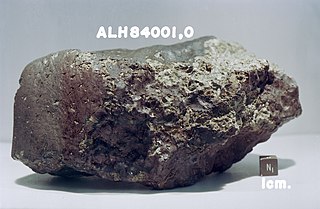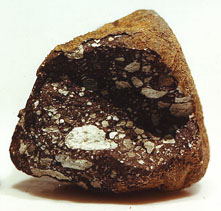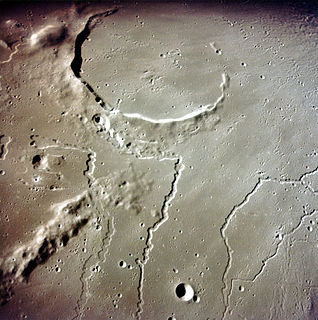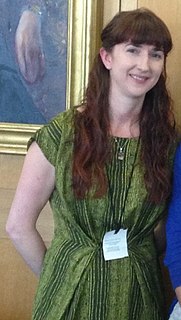
Phobos is the innermost and larger of the two natural satellites of Mars, the other being Deimos. Both moons were discovered in 1877 by American astronomer Asaph Hall.

Allan Hills 84001 is a fragment of a Martian meteorite that was found in the Allan Hills in Antarctica on December 27, 1984, by a team of American meteorite hunters from the ANSMET project. Like other members of the shergottite–nakhlite–chassignite (SNC) group of meteorites, ALH84001 is thought to have originated on Mars. However, it does not fit into any of the previously discovered SNC groups. Its mass upon discovery was 1.93 kilograms (4.3 lb).

Eugene Merle (Gene) Shoemaker was an American geologist and one of the founders of the field of planetary science. He co-discovered Comet Shoemaker–Levy 9 with his wife Carolyn S. Shoemaker and David H. Levy. This comet hit Jupiter in July 1994: the impact was televised around the world. Shoemaker also studied terrestrial craters, such as Barringer Meteor Crater in Arizona, and was the first scientist to conclude that these craters were caused by meteor impacts. He was also the first director of the United States Geological Survey's Astrogeology Research Program.

A lunar meteorite is a meteorite that is known to have originated on the Moon. A meteorite hitting the Moon is normally classified as a transient lunar phenomenon.

The Discovery Program is a series of Solar System exploration missions funded by the US National Aeronautics and Space Administration (NASA) through its Planetary Missions Program Office. Each mission has a cost cap, at a lower level than a mission from NASA's New Frontiers or Flagship Programs. As a result, Discovery missions tend to be more focused on a specific scientific goal.
Ben J. Bussey is an American planetary scientist.
George Wetherill was the Director Emeritus, Department of Terrestrial Magnetism, Carnegie Institution of Washington, DC, USA.
The Lunar and Planetary Institute (LPI) is a scientific research institute dedicated to study of the solar system, its formation, evolution, and current state. The Institute is part of the Universities Space Research Association (USRA) and is supported by the Science Mission Directorate of the National Aeronautics and Space Administration (NASA). Located at 3600 Bay Area Boulevard in Houston, Texas, the LPI maintains an extensive collection of lunar and planetary data, carries out education and public outreach programs, and offers meeting coordination and publishing services. The LPI sponsors and organizes several workshops and conferences throughout the year, including the Lunar and Planetary Science Conference (LPSC) held in March in the Houston area.
Doris Daou is a Lebanese-born astronomer from Canada who was formerly the Director for Education and Public Outreach of the NASA Lunar Science Institute and the Associate Director of the NASA Solar System Exploration Research Virtual Institute (SSERVI), and is currently the program contact for NASA's "Small Innovative Missions for Planetary Exploration (SIMPLEx)".

Maria T. Zuber is a member of the National Science Board and the Vice President for Research at the Massachusetts Institute of Technology, where she also holds the position of the E. A. Griswold Professor of Geophysics in the Department of Earth, Atmospheric and Planetary Sciences. Zuber has been involved in more than half a dozen NASA planetary missions aimed at mapping the Moon, Mars, Mercury, and several asteroids. She is currently the principal investigator for the Gravity Recovery and Interior Laboratory (GRAIL) Mission, which is managed by NASA's Jet Propulsion Laboratory.

David Stewart McKay was Chief Scientist for astrobiology at the Johnson Space Center. During the Apollo program, McKay provided geology training to the first men to walk on the Moon in the late 1960's. McKay was the first author of a scientific paper postulating past life on Mars on the basis of evidence in Martian meteorite ALH 84001, which had been found in Antarctica. This paper has become one of the most heavily cited papers in planetary science. The NASA Astrobiology Institute was founded partially as a result of community interest in this paper and related topics. He was a native of Titusville, Pennsylvania.
Peter H. Schultz is Professor of Geological Sciences at Brown University specializing in the study of planetary geology, impact cratering on the Earth and other objects in the Solar System, and volcanic modifications of planetary surfaces. He was co-investigator to the NASA Science Mission Directorate spacecraft Deep Impact and the Lunar Crater Observation and Sensing Satellite (LCROSS). He was awarded the Barringer Medal of the Meteoritical Society in 2004 for his theoretical and experimental studies of impact craters.

Traces of Catastrophe: A Handbook of Shock-Metamorphic Effects in Terrestrial Meteorite Impact Structures is a book written by Bevan M. French of the Smithsonian Institution. It is a comprehensive technical reference on the science of impact craters. It was published in 1998 by the Lunar and Planetary Institute (LPI), which is part of the Universities Space Research Association (USRA). It was originally available in hard copy from LPI, but is now only available as a portable document format (PDF) e-book free download.

Dr. Laurie Leshin is the 16th president of Worcester Polytechnic Institute, and is the first female president in the institution's 150-year history. Leshin is an accomplished academic and administrative leader, geochemist, and space scientist.

Planetary science or, more rarely, planetology, is the scientific study of planets, moons, and planetary systems and the processes that form them. It studies objects ranging in size from micrometeoroids to gas giants, aiming to determine their composition, dynamics, formation, interrelations and history. It is a strongly interdisciplinary field, originally growing from astronomy and earth science, but which now incorporates many disciplines, including planetary geology, cosmochemistry, atmospheric science, oceanography, hydrology, theoretical planetary science, glaciology, and exoplanetology. Allied disciplines include space physics, when concerned with the effects of the Sun on the bodies of the Solar System, and astrobiology.

Allan Hills A81005 or ALH A81005 was the first lunar meteorite found on Earth. It was found in 1982 in the Allan Hills at the end of the Transantarctic Mountains, during a meteorite gathering expedition (ANSMET).
Catherine Margaret Corrigan, often known as Cari Corrigan, is an American scientist best known as a curator of the meteorite collection at the Smithsonian Institution. She is a scientist in the Department of Mineral Science at the National Museum of Natural History.

Barbara Cohen is a planetary scientist at NASA's Goddard Space Flight Center. The asteroid 6816 Barbcohen is named after her.
Faith Vilas is an American planetary scientist and Director of the MMT Observatory in Arizona.

Katherine Helen Joy is a Reader in Earth Sciences at the University of Manchester. Joy has studied lunar samples from the Apollo program as part of her research on meteorites and lunar science.











